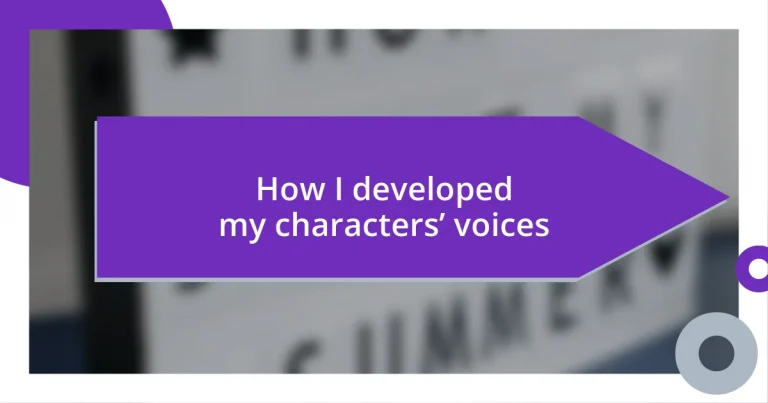Key takeaways:
- Character voice reflects backgrounds, emotions, and personalities; authenticity is crucial for relatability.
- Exploring dialects, accents, and unique speech patterns enhances character identity and reader immersion.
- Incorporating emotional depth through dialogue and practicing character voice in various scenarios enriches storytelling and connection.
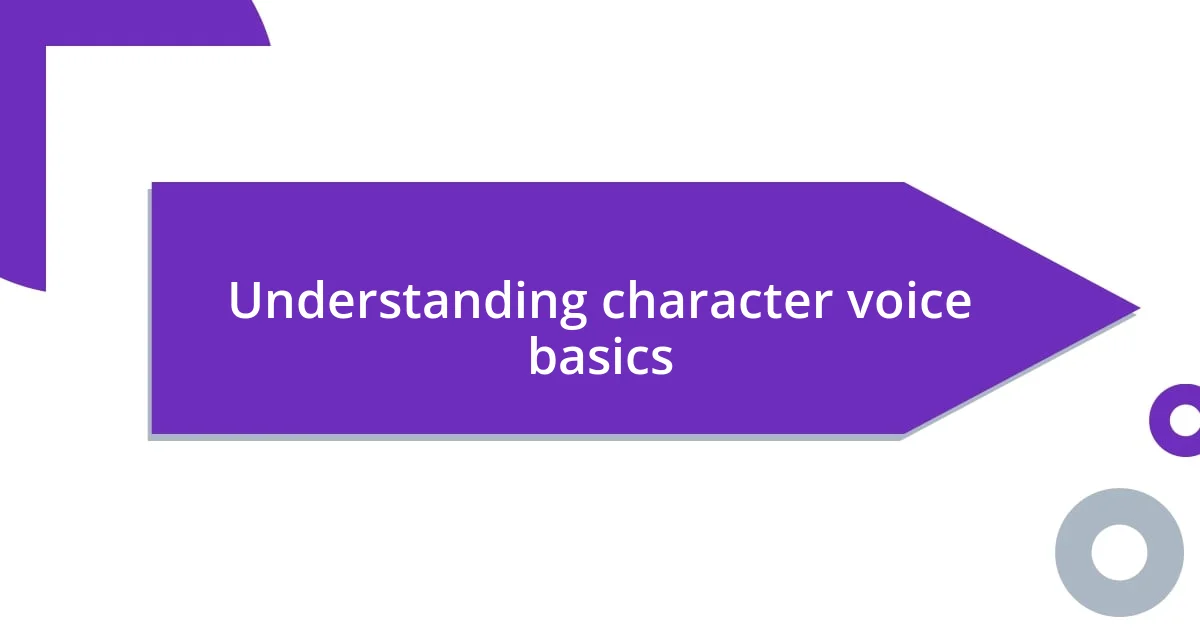
Understanding character voice basics
Character voice is more than just the words they say; it reflects their background, emotions, and personality. I remember when I was developing my character, Sarah, who grew up in a bustling city. Her dialogue was peppered with urban slang and a fast-paced rhythm, which immediately gave readers a glimpse into her world. Isn’t it fascinating how word choice can evoke an entire lifestyle?
Each character has a unique cadence, influenced by their experiences and emotions. For instance, developing my character Tom, who had a more rural upbringing, was a different challenge. His voice adopted a slower, more deliberate pace, incorporating idioms from his countryside roots. I often ask myself: if I met this character in real life, how would their tone and pace make me feel? The answer shapes how I write their voice.
Ultimately, understanding character voice is about authenticity. Readers can sense when a character’s voice feels forced or untrue to their experiences. Finding that genuine sound often requires me to listen closely to the rhythms of real-life conversations. I’ll often jot down snippets of dialogue I hear in cafés or on public transport—little treasures that spark inspiration and lend credibility to my characters’ voices.

Finding your character’s background
To truly grasp a character’s voice, delving into their background is essential. When I created Lily, a first-generation immigrant, her struggles and triumphs intermingled to shape her speech. I vividly remember writing a scene where her accent slipped into a stronger melody when she spoke of her childhood, which added depth to her personality. Have you ever noticed how someone’s story can dramatically alter their tone and choice of words?
Exploring a character’s background allows me to unlock layers of their identity. One of my characters, Marco, was raised in a family of musicians. I illustrated his voice with musical metaphors, reflecting the rhythm and harmony he experienced growing up. This detail not only made him relatable but also invited readers to feel the joy and struggle inherent in those rhythms.
The more I invest in understanding where my characters come from, the richer their voices become. For instance, when I crafted Jenna, whose life revolved around her grandmother’s old bookstore, her dialogue became infused with literary references and a certain wistfulness. Capturing those little nuggets of background adds authenticity. Isn’t it interesting how these elements evolve into distinctive voices that resonate with readers?
| Key Aspect | Example |
|---|---|
| Character Background | Lily, the Immigrant |
| Influences on Voice | Musical Family (Marco) |
| Authenticity | Bookstore Heritage (Jenna) |
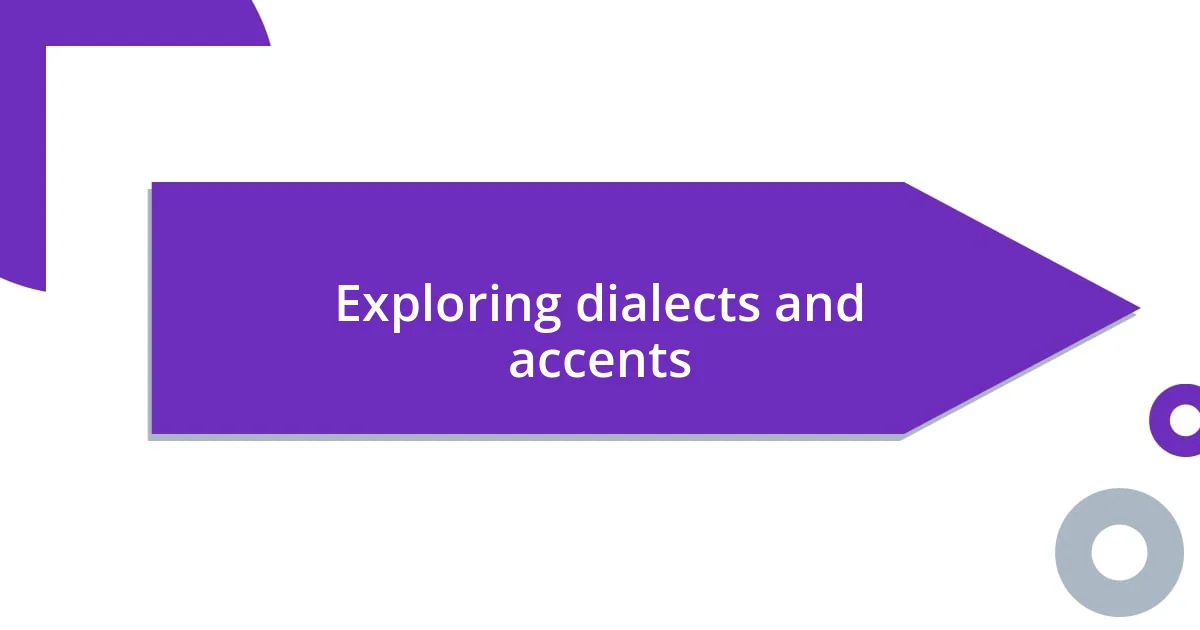
Exploring dialects and accents
Exploring dialects and accents adds a unique flavor to character development. I remember attending a local theater performance where the actors used regional dialects so masterfully that I could feel the essence of their characters. The subtle shifts in intonation and word choice transported me into their world, showcasing how essential dialect can be. It’s like meeting someone and immediately feeling connected through shared culture and language nuances.
- Dialects ground characters in place and culture.
- Accents can signify socioeconomic status or education level.
- Unique speech patterns can reflect a character’s personality and mood.
- Incorporating real-world listening experiences can enhance authenticity.
- Characters with distinct dialects often stand out, making them memorable to readers.
In my writing, I find it enlightening to listen to how friends speak based on their backgrounds. I once had a conversation with a friend from Scotland whose accent danced through their words, revealing warmth and friendliness. It struck me that even the smallest slip into dialect could transform my character’s voice. I aim to embed those dialectical features in my stories, illustrating a character’s uniqueness through their speech patterns and nuances. This exploration deepens both the character’s identity and the readers’ immersion into their world.
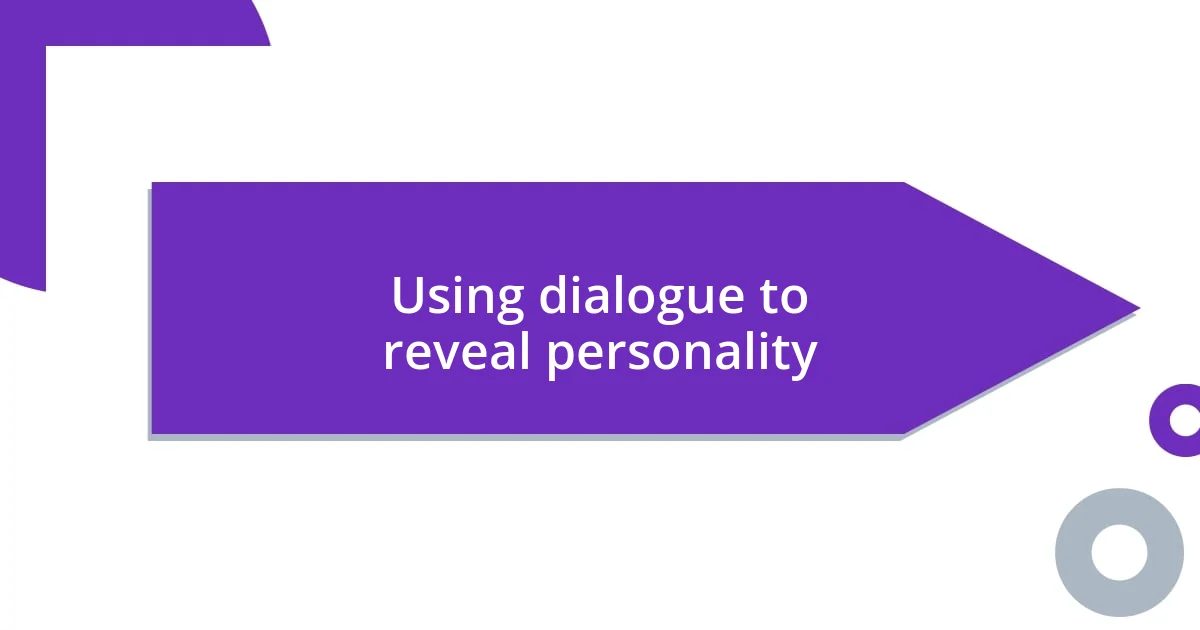
Using dialogue to reveal personality
Capturing a character’s personality through dialogue is one of the most rewarding aspects of writing. When I penned a scene between two siblings, their banter flowed naturally, revealing not just their strong bond but also their distinct personalities. One sibling’s sarcasm contrasted sharply with the other’s earnestness, illustrating how their shared history shaped their communication style. Have you ever noticed how a smart quip can say more about someone than a long, thoughtful speech?
I often reflect on conversations I’ve had with friends, particularly moments where their speech slipped into playful teasing or heartfelt sincerity. For instance, a dear friend of mine has a way of delivering her thoughts with such palpable enthusiasm that it lights up the entire room. This inspired me to create a character whose excitement is contagious—a voice that infuses every dialogue line with energy, revealing her passionate nature. Have you found that certain people instantly reveal their core by how they communicate?
Incorporating these layers into dialogue not only conveys personality but also builds emotional connections with readers. I remember crafting a pivotal moment where a character’s voice wavered at a critical juncture, hinting at their vulnerability. That moment resonated deeply with readers, showing how dialogue can serve as a window into a character’s soul. Have you considered how a single word choice can encapsulate a wealth of emotion? It’s this delicate interplay of dialogue that turns static characters into vibrant, memorable voices.
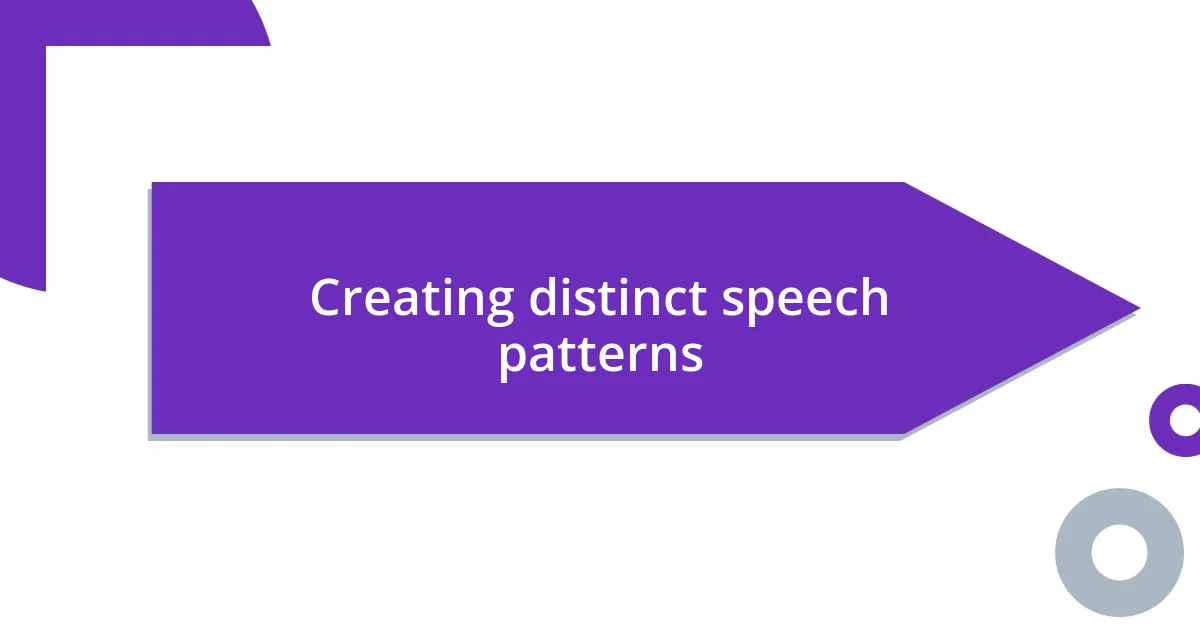
Creating distinct speech patterns
Creating distinct speech patterns is an art form that brings characters to life on the page. I often think about how the rhythm and tempo of someone’s speech can shape our understanding of them. For instance, I have a friend who speaks in clipped, energetic bursts, which immediately conveys her urgency and enthusiasm. I’ve found that mirroring those real-life nuances in my writing helps fill my characters with authenticity.
One technique that has worked wonders for me is experimenting with word choice and phrasing. I remember writing a character who insists on using outdated slang; this decision added a layer of endearing quirkiness. It’s fascinating how a simple expression can reveal so much—it makes me wonder, have you ever met someone whose language instantly transported you to another era? Those moments can be gems in storytelling, signaling a character’s background and emotional state.
Sometimes, I incorporate pauses and interruptions to create tension or a sense of hesitation in dialogue. I recall a scene where two characters were having a heated argument; their lines were punctuated with sharp breaths and faltering words, reflecting their struggle to communicate amidst their emotions. This approach not only gave depth to their voices but also invited readers to feel the weight of their conflict. Isn’t it incredible how speech patterns can encapsulate a character’s internal world? It’s an ongoing journey to refine those patterns, and I relish every moment of that exploration.
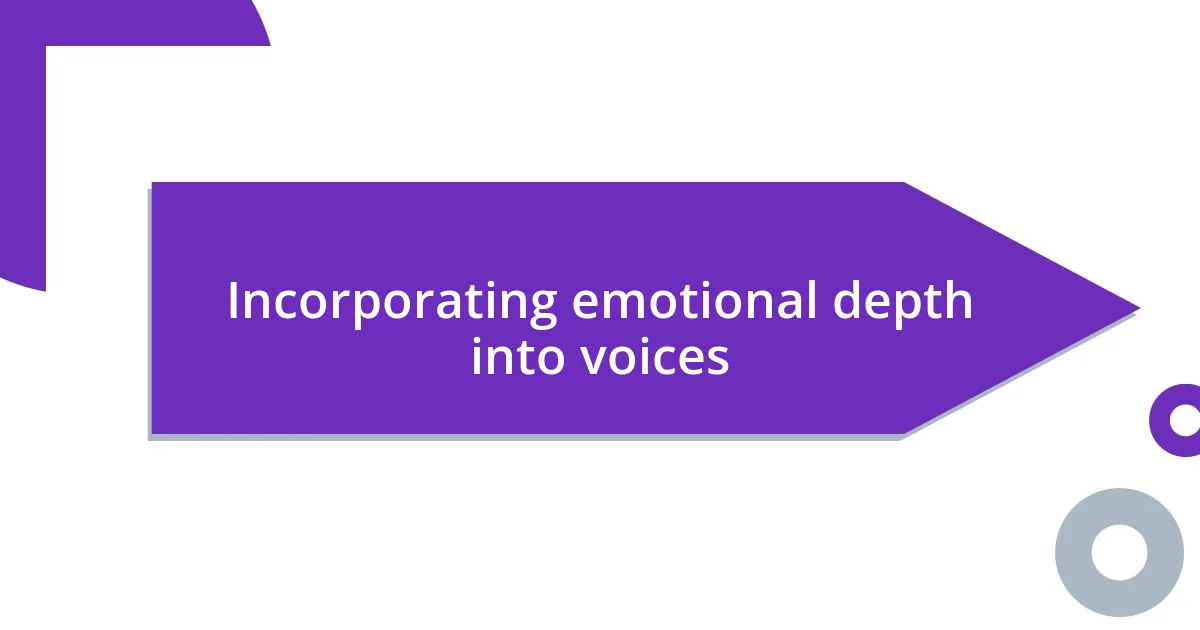
Incorporating emotional depth into voices
Incorporating emotional depth into a character’s voice requires a keen sensitivity to the nuances of feelings. I often find myself reflecting on times when my emotions dictated my tone—like that moment when I received unexpected news. The tremor in my voice spoke volumes, much more than any well-thought-out response ever could. Have you ever encountered a situation where your feelings transformed the way you communicated? It’s those vivid emotions that can breathe life into my characters, making their voices resonate with authenticity.
When crafting dialogue, I pay particular attention to the emotional backdrop of each scene. For example, I once wrote a character who had just experienced a loss. By having her speak in soft, measured phrases, I illustrated her muted grief effectively. This restraint in her voice invited readers to feel her pain without being overtly graphic. How often do we hear someone say fewer words yet convey so much more? I believe this delicate balance is essential—it helps in painting an emotional landscape that readers can navigate alongside the characters.
Rhetorical questions often pop into my mind as I write, prompting me to explore deeper layers of emotional resonance. I once had a character grappling with self-doubt, and during a pivotal conversation, her voice trembled with unspoken words and fears. By using hesitant speech patterns and fragmented sentences, I captured her vulnerability perfectly. Isn’t it fascinating how the nuances of speech can reveal so much about our emotional states? This process of embedding emotional depth into characters’ voices is something I cherish, as it fosters a rich connection between the reader and the narrative.

Practicing character voice through scenes
Practicing character voice through scenes can be a revelatory experience. I often find that immersing myself in specific scenarios helps me discover unexpected aspects of a character’s voice. For instance, I once wrote a scene where a character was in a café, sipping coffee amidst the hustle and bustle. The clinking of cups and muffled conversations became a backdrop against which her voice emerged, laced with impatience. That environment shaped her dialogue and transformed her character—who knew background noise could illuminate inner tension?
Another effective strategy I’ve employed is role-playing different characters in various settings. There was a moment when I acted out a scene in front of a mirror, embodying a character who felt out of place at a formal gathering. As I adjusted my posture and facial expressions, I noticed how her dialogue evolved. She used longer, more hesitant phrases, tinged with sarcasm—this embodied her discomfort beautifully. Have you ever tried speaking aloud as your characters? It can unlock aspects of their personalities that you didn’t realize existed!
I believe that the dynamics between characters can also enhance their voices. Consider a scene where a jubilant character interacts with a more somber one. I recall writing a moment where they shared a quiet laugh, and the contrast in their speech highlighted their relationship. The jovial character bubbled with enthusiasm, while the other responded with dry wit. That playful back-and-forth revealed their friendship’s complexity—it’s moments like these that make me wonder: how do our interactions shape the way we express ourselves? By practicing character voice through scenes, I’ve come to appreciate the subtleties that give depth to my characters and make their dialogue truly resonate.












